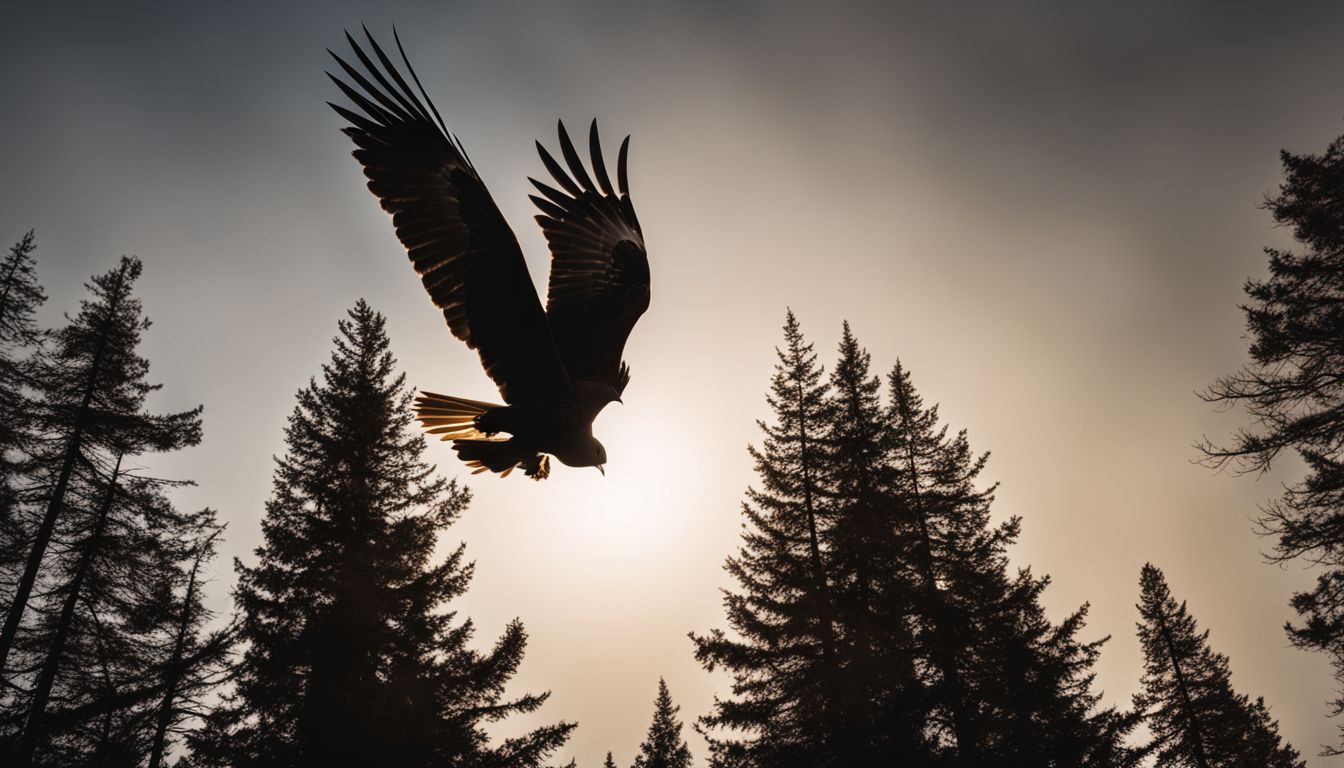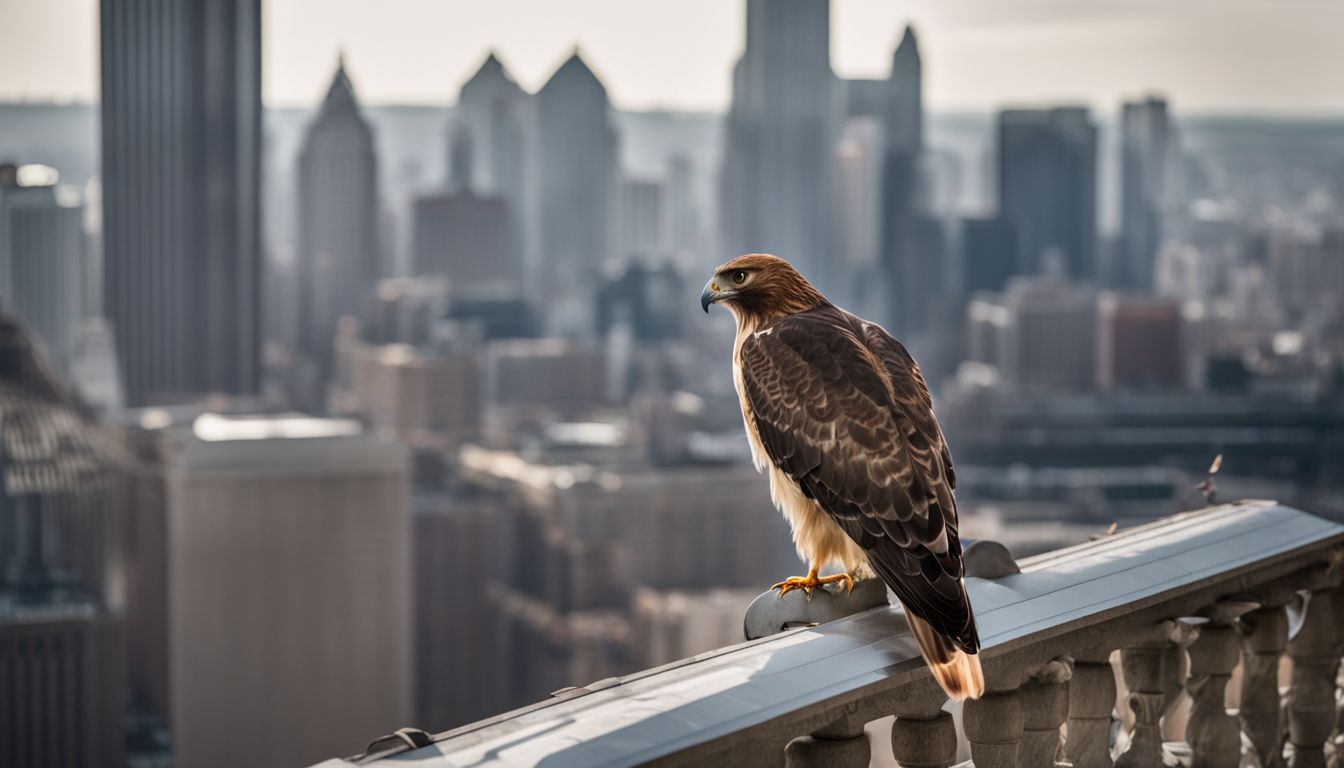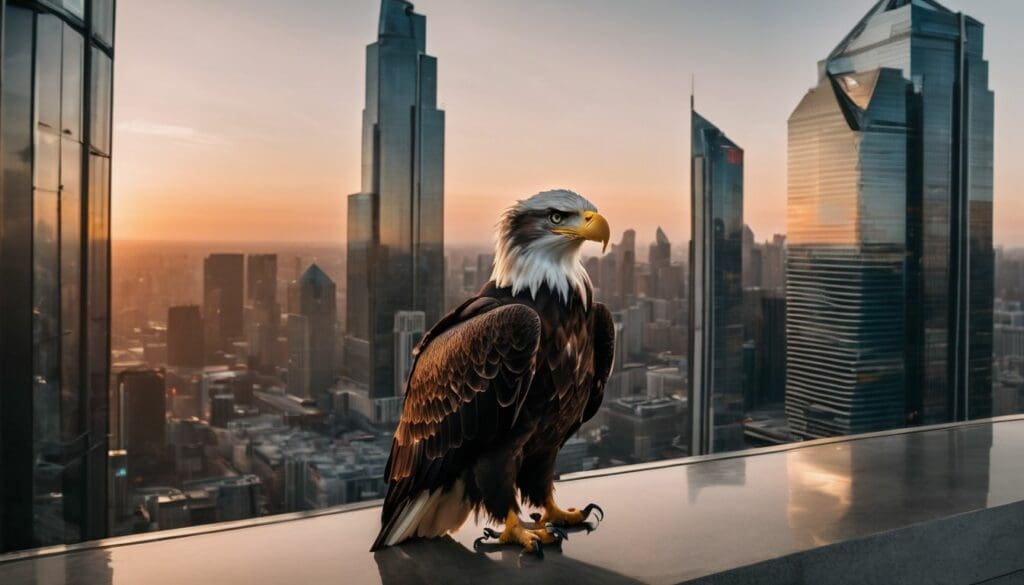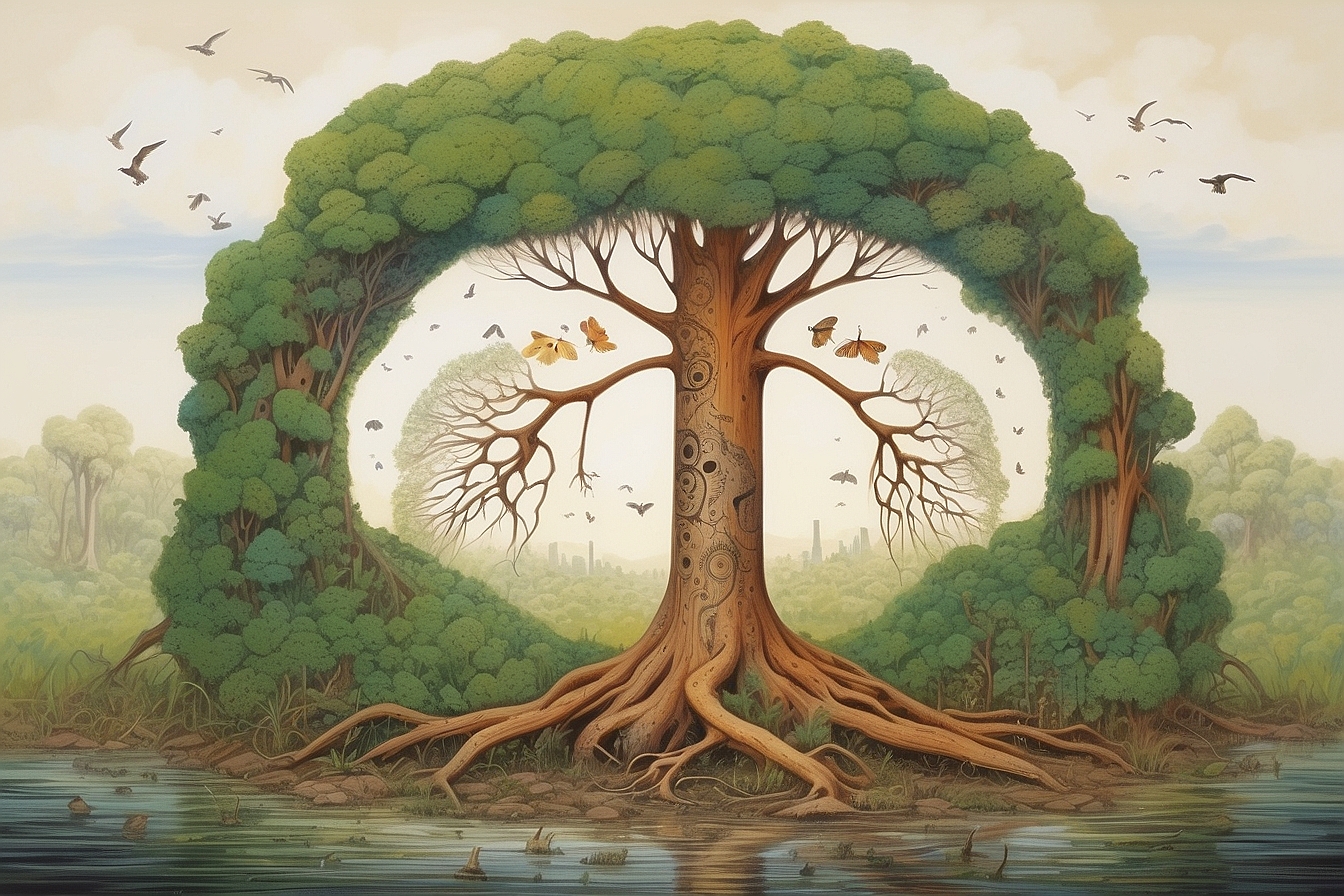Many of us are utterly enchanted by the sight of those noble birds of prey, with their soaring grace that seems so at odds with our bustling city landscapes. A sense of wonder grips us as we learn that there exist a remarkable 10,000 breeding pairs of peregrine falcons across the globe.
Our journey into understanding takes us closer to how these splendid raptors have embraced urban life and what this signifies for their destiny amidst our concrete jungles. So let’s delve together into this fascinating intersection where wild elegance coexists with metropolitan bustle!
Key Takeaways
- Hawks and eagles, known as raptors, have successfully adapted to life in cities by using tall buildings for nesting and preying on urban wildlife like pigeons and rodents.
- Urban challenges such as limited natural habitats, collisions with buildings, human disturbances, pollution, competition for space, and disease transmission test the adaptability of these birds.
- Community science is crucial for raptor conservation in urban environments; citizen observations help professionals track bird behaviours, migratory patterns and inform effective strategies to protect them.
- Peregrine falcons use skyscrapers as cliff-like nesting sites while red-tailed hawks hunt in green spaces within cities. Strategies like adjusting hunting times and diet flexibility enable their survival amidst urbanisation.
- The presence of raptors in city landscapes serves as a powerful indicator of ecological health and our role in maintaining biodiversity through habitat protection efforts.
Understanding Raptors: Hawks and Eagles

We often marvel at the sight of hawks and eagles soaring high above us, their keen eyes searching for prey. These majestic birds are known as raptors, a group that also includes falcons, owls, and buzzards.
Hawks, such as the red-tailed hawk (Buteo jamaicensis), and eagles like the bald eagle (Haliaeetus leucocephalus), possess powerful talons and hooked beaks designed for hunting and feeding on other animals.
Eagles tend to be larger than most other raptors, with impressive wingspans allowing them to glide effortlessly across vast distances. In contrast, hawks display remarkable agility which aids them in navigating through dense forests or urban landscapes.
Both bird groups have evolved incredible vision; they can spot a rodent from hundreds of feet in the air or keep a sharp eye on fish swimming just below the water’s surface. Studying these predators provides valuable insights into ecosystem health and biodiversity crisis indicators due to their position at the top of the food chain.
Engaging with community science helps deepen our understanding of these avian hunters’ habits, migration patterns, nesting preferences, and how they adapt to changing environments.
As we observe their behaviours closely – from courtship dances high in the sky to intricate nest-building techniques – we learn about resilience and adaptation strategies crucial for survival amidst habitat loss and biological invasion threats.
Our collective effort can contribute significantly to effective raptor conservation initiatives ensuring that future generations continue witnessing these predatory birds’ awe-inspiring presence in both rural wildlands and increasingly common urban settings.
Raptors Adapting to Urban Environments

In our urban jungles, a surprising array of raptors are taking wing and carving out territories where we least expect them. These birds of prey are rewriting the rulebook on habitat adaptation, turning skyscrapers into cliffs and city pigeons into plentiful prey.
Red-tailed Hawk (Buteo jamaicensis)
We often spot Red-tailed Hawks soaring above cityscapes, a majestic sight against concrete and steel. These adaptable raptors have made themselves at home in urban environments across the country.
Their distinctive reddish-brown tail feathers catch the sunlight as they glide on warm air currents looking for prey.
These birds of prey have learned to hunt in busy streets, preying on rodents which helps control urban pest populations. Nesting high up on buildings or in tall trees, they raise their young amidst the hustle and bustle.
We admire their resilience and how they contribute to maintaining an ecological balance even within our cities. By protecting green spaces and promoting healthy ecosystems, we can ensure that Red-tailed Hawks continue to thrive alongside us.
Peregrine Falcon (Falco peregrinus)
Shifting our focus from the adaptable red-tailed hawk, the peregrine falcon, also known as Falco peregrinus, displays its own remarkable adaptability in urban settings. These powerful raptors make towering skyscrapers their home, using the high vantage points to spot prey and perform their characteristic high-speed dives or ‘stoops.’ They hunt with breathtaking precision, capturing smaller birds mid-air and bringing an element of wildness to city skies.
Peregrine falcons have made a significant comeback from the brink of extinction thanks to concerted conservation efforts. Today, they are a testament to resilience within metropolitan landscapes.
By nesting on tall buildings that echo their natural cliffside habitats, these bird of prey have shown incredible urban tolerance. Their presence in cities helps balance ecosystems by controlling populations of pigeons and other small birds.
Each sighting reminds us that even amidst concrete and steel, nature finds a way to thrive.
American Kestrel (Falco sparverius)
Transitioning from the prowess of the Peregrine Falcon, we find ourselves admiring the American Kestrel, a smaller but no less remarkable raptor. Known as Falco sparverius, these vibrant birds add a splash of colour to urban skies with their russet backs and slate-blue wings.
We often spot them perched high on wires or swooping gracefully through the air to snatch up insects and small rodents.
American Kestrels have adapted expertly to city life. They use buildings for nesting just like their larger raptor relatives and are skillful hunters despite their diminutive size.
Observing kestrels can be an exhilarating experience as they hover in place with rapid wing beats before diving down at impressive speeds to capture prey – a display of aerial agility that brightens our concrete jungles.
Their presence reminds us that even smaller species play vital roles in ecosystem functioning and urban biodiversity.
Bald Eagle (Haliaeetus leucocephalus)
Moving from the compact agility of the American Kestrel, we find ourselves in awe of a larger raptor that has learned to navigate cityscapes: the majestic Bald Eagle. These powerful birds soar above urban areas with an impressive wingspan and piercing eyes, on the lookout for open waterways and large trees to nest in.
Their adaptation skills are remarkable; they often choose locations near reservoirs or rivers, aligning their hunting strategy with resource availability. Our collective efforts to clean up waterways have played a part in their urban success story.
Bald Eagles showcase incredible resilience by adjusting their diet to include food sources found within cities, like feral pigeons and other small mammals. They utilise tall buildings as perches for scanning their territory and rely on undisturbed green spaces for roosting.
We see them as symbols of strength and freedom, but it’s our duty to ensure these iconic birds continue to thrive amidst skyscrapers and traffic by protecting natural habitats within our bustling cities.
The Impact of Urbanisation on Raptors
Urbanisation introduces a myriad of hurdles for raptors, altering their natural habitats and testing their adaptability. We’ll explore how these birds face and often overcome obstacles in the concrete jungle, shaping the skies above our cities.
Challenges faced by raptors in cities
We often see raptors gliding above urban landscapes, but these warriors of the sky face many hurdles in our cities. Here’s a look at the challenges that test their survival skills every day:
Strategies used by raptors to thrive in urban areas
- Raptors exploit tall buildings as nesting sites, much like their natural cliff – side habitats. These structures provide both height for a good vantage point and warmth from residual heat.
- They capitalise on the abundance of pigeons and rodents in cities, which ensures a stable food supply for species such as Peregrine Falcons and Cooper’s Hawks.
- Some raptors have adjusted their hunting times. Nocturnal raptors like the Great Horned Owl use the cover of night to hunt in peace, while diurnal species take advantage of daylight hours.
- Urban raptors conserve energy by riding thermals—updrafts of warm air—over heated cityscapes, allowing them to soar without much flapping.
- Adaptable species like Red – tailed Hawks have broadened their tolerance for human activity; they’re often seen unbothered by traffic or noise while perched atop streetlights.
- Nesting materials are plentiful in urban settings. Raptors make use of twigs, plastic, and even metal wires found around cities to construct sturdy nests.
- Intelligent birds such as the Bald Eagle display remarkable flexibility in diet choices; they’ve been observed fishing in urban water bodies or scavenging on carrion when live prey is scarce.
- Seasonal migrants like Ospreys take full advantage of man – made structures such as poles and platforms erected specifically for them to nest upon during breeding season.
The Role of Community Science in Raptor Conservation
We’re seeing an encouraging surge in community science, where local observations are bolstering the conservation efforts for urban raptors. Citizen participation is rapidly becoming a cornerstone for initiatives aimed at understanding and protecting these majestic birds within our bustling city landscapes.
Importance of citizen science
Citizen science plays a crucial role in the conservation of raptor species. By engaging non-scientists in data collection and observation, we gather valuable information on how birds such as red-shouldered hawks and peregrine falcons interact with urban environments.
Everyday folk contribute by reporting sightings, nesting locations, and foraging behaviour. These insights help professionals understand changes in population dynamics and habitat use.
We rely on community observations to track migratory patterns too. Through public participation, scientists receive updates on when and where migratory species like snowy owls appear within city limits.
This collaborative approach enriches our knowledge pool and shapes effective conservation strategies to protect these majestic birds amidst the challenges of urbanisation. Let’s turn our attention now to how this citizen-gathered data is used effectively for raptor conservation.
Use of community science data for raptor conservation
We’re tapping into the power of community science to safeguard our magnificent raptors. People like us, passionate about wildlife, contribute vital information by reporting sightings and behaviours of species such as Red-tailed Hawks or Peregrine Falcons.
This data forms an extensive pool that experts analyse to understand how birds like Barn Owls and American Kestrels are coping in an ever-changing urban landscape.
Our collective observations help build a clearer picture of where these birds nest, hunt, and migrate through cities. They alert conservationists to potential ecological traps or areas where raptors thrive despite urbanisation challenges.
Harnessing this knowledge enables us to create better strategies for protecting these powerful predators, ensuring their presence remains a testament to the resilience of nature amidst bustling city life.
Through our efforts in tracking and reporting, we play a critical role in shaping the future for raptor species across urban environments.
Case Study: Raptors in New York City
New York City’s skyline tells a modern tale, but its true citizens are more than just people. Among them soar amazing raptors like peregrine falcons and red-tailed hawks. These fierce hunters have adapted to the urban jungle, nesting on skyscrapers and hunting amidst the hustle.
They glide between buildings with ease, proving that even in the heart of Manhattan, wildlife can thrive.
Our team observes these birds closely, marvelling at their resilience. Peregrine falcons claim high ledges for their nests – including bridges and tall buildings – while red-tailed hawks prefer leafy parks and cemeteries as hunting grounds.
These adaptations show us nature’s versatility and inspire our efforts in conservation work across bustling cities where people might not expect to find such majestic creatures thriving against all odds.
Conclusion
In our bustling cities, raptors like hawks and eagles are finding new ways to survive. They soar above skyscrapers and nest on ledges, proving nature’s resilience. Our awareness can lead to actions that protect these majestic birds for future generations.
Let us embrace the sight of these winged hunters as a symbol of urban wildlife success. Together, we ensure their stories continue in the concrete jungles we call home.
FAQs
1. What are some common raptors seen in urban environments?
In cities, you might spot peregrine falcons, commonly known as pigeon hawks or duck hawks, northern goshawks, and occasionally even majestic birds like the wedge-tailed eagle or black-shouldered kite soaring above.
2. Can large raptors like eagles adapt to city life?
Yes, larger raptors such as eagles can adapt to urban settings; species like the Aquila audax have been observed adjusting their hunting strategies and habitat use within city landscapes.
3. Why are smaller raptors like kestrels also found in cities?
Smaller raptor species such as the nankeen kestrel adapt well to urban areas because they can easily hunt for prey around buildings and parks where food sources may be abundant.
4. How do university studies help us understand urban raptors?
Research from institutions like the University of Vienna provides valuable data on body mass differences between rural and urban birds, changes in habitat breadth, and how these factors affect various raptor species’ survival in cities.
5. Are nocturnal owls common in city environments?
Yes! Nocturnal owls such as Tyto alba (barn owl), bubo virginianus (great horned owl), and Ninox connivens (southern boobook) have all been noted to thrive within certain urban settings by adapting their habits accordingly.
6. What role does nest substrate breadth play for urban-dwelling birds of prey?
Nest substrate breadth is important because it measures how adaptable a bird is regarding where it can build its nest – a key factor that affects whether diurnal raptors like falcons or merlins can settle successfully into an urban ecosystem.





